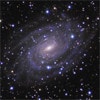KFC launches sandwich into space

He wants to send KFC's spicy Zinger sandwich into space. Unlike "most terrestrial chicken sandwiches," claims Lowe, KFC's are hand-breaded.
As to whether performing the feat of sending this concoction into space is possible, Lowe will only admit: "We certainly hope so. Our entire marketing campaign depends on it."
UK schoolboy corrects Nasa data error

The correction was said to be "appreciated" by Nasa, which invited him to help analyse the problem.
The research was part of the TimPix project from the Institute for Research in Schools (IRIS), which gives students across the UK the chance to work on data from the space station, looking for anomalies and patterns that might lead to further discoveries.
It turned out that Miles had noticed something no-one else had - including the Nasa experts.
SpaceX successfully launches rocket after Saturday setback

It was the first mission by the company since one of its vehicles exploded on the launch pad in September.
The company also has a long queue of customers all waiting for a ride to orbit - including America's civil space agency (Nasa), the US military and multiple outfits in the commercial sector.
Computing glitch may have doomed Mars lander

The lander’s heat shield and parachute ejected ahead of time, says Vago. Then thrusters, designed to decelerate the craft for 30 seconds until it was metres off the ground, engaged for only around 3 seconds before they were commanded to switch off, because the lander's computer thought it was on the ground.
The most likely culprit is a flaw in the craft’s software or a problem in merging the data coming from different sensors, which may have led the craft to believe it was lower in altitude than it really was, says Andrea Accomazzo, ESA’s head of solar and planetary missions.
We Were Very Wrong About the Number of Galaxies in the Universe

The observable universe—that is, the part of the universe that’s visible to us on Earth—contains 10 to 20 times as many galaxies than previous estimates. That raises the total to somewhere between one and two trillion galaxies, which is up from the previous best estimate of 100 billion galaxies. Consequently, this means we also have to update the number of stars in the observable universe, which now numbers around 700 sextillion (that’s a 7 with 23 zeros behind it, or 700 thousand billion billion).
SpaceX rocket explodes at Cape Canaveral ahead of launch

SpaceX said "an anomaly" had occurred while the rocket was being loaded with fuel. No-one was injured, it said.
The rocket's payload, an Israeli-built communications satellite for Facebook due to launch on Saturday, was also destroyed, it added.
Facebook founder Mark Zuckerberg, who is currently visiting Africa, said he was "deeply disappointed" to hear that the satellite had been destroyed.
Was it a meteorite? Tests will determine what killed Indian man

Indian scientists will examine remains from an object that fell from the sky Saturday, causing a large explosion which killed a man, to determine if it is a meteorite, police say.
Senthil Kumari said it was yet to be confirmed whether the object that caused the blast was a meteorite, as opposed to falling space junk or some other form of debris.
The Man Who Turned Night Into Day

Throughout the early 90s, a team of Russian astronomers and engineers were hellbent on literally turning night into day. By shining a giant mirror onto the earth from space, they figured they could bring sunlight to the depths of night, extending the workday, cutting back on lighting costs and allowing laborers to toil longer.
As planned, on February 4, Znamya left Mir. When it found its orbit a safe distance away, the mirror successfully deployed. And, sure enough, it sent a five kilometer-wide beam of light back down to Earth. The beam swept through Europe, moving from the south of France to western Russia at a reported speed of eight kilometers per second.
The Most Mysterious Star in Our Galaxy

“We’d never seen anything like this star,” says Tabetha Boyajian, a postdoc at Yale. “It was really weird. We thought it might be bad data or movement on the spacecraft, but everything checked out.”
When I spoke to Boyajian on the phone, she explained that her recent paper only reviews “natural” scenarios. “But,” she said, there were “other scenarios” she was considering.
Wright and his co-authors say the unusual star’s light pattern is consistent with a “swarm of megastructures,” perhaps stellar-light collectors, technology designed to catch energy from the star.
Russia's New Rocket Won't Fit in Its New Cosmodrome

Work at Russia's new $ 3 billion spaceport in the Far East has ground to a halt after a critical piece of infrastructure was discovered to have been built to the wrong dimensions, and would not fit the latest version of the country's Soyuz rocket, a news report said.
The project has come under strict scrutiny from Russian officials such as President Vladimir Putin - who last year demanded the facility be ready for a first launch in December 2015 - and Deputy Prime Minister Dmitry Rogozin, who has threatened to rip the heads off any contractors that slow up construction efforts.